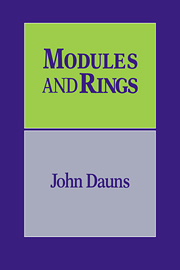Book contents
- Frontmatter
- Contents
- PREFACE
- NOTE TO THE READER
- CHAPTER 1 MODULES
- CHAPTER 2 FREE MODULES
- CHAPTER 3 INJECTIVE MODULES
- CHAPTER 4 TENSOR PRODUCTS
- CHAPTER 5 CERTAIN IMPORTANT ALGEBRAS
- CHAPTER 6 SIMPLE MODULES AND PRIMITIVE RINGS
- CHAPTER 7 THE JACOBSON RADICAL
- CHAPTER 8 SUBDIRECT PRODUCT DECOMPOSITIONS
- CHAPTER 9 PRIMES AND SEMIPRIMES
- CHAPTER 10 PROJECTIVE MODULES AND MORE ON WEDDERBURN THEOREMS
- CHAPTER 11 DIRECT SUM DECOMPOSITIONS
- CHAPTER 12 SIMPLE ALGEBRAS
- CHAPTER 13 HEREDITARY RINGS, FREE AND PROJECTIVE MODULES
- CHAPTER 14 MODULE CONSTRUCTIONS
- CHAPTER 15 CATEGORIES AND FUNCTORS
- CHAPTER 16 MODULE CATEGORIES
- CHAPTER 17 FLAT MODULES
- CHAPTER 18 PURITY
- APPENDIX A BASICS
- APPENDIX B CERTAIN IMPORTANT ALGEBRAS
- LIST OF SYMBOLS AND NOTATION
- BIBLIOGRAPHY
- SUBJECT INDEX
- AUTHOR INDEX
CHAPTER 18 - PURITY
Published online by Cambridge University Press: 20 October 2009
- Frontmatter
- Contents
- PREFACE
- NOTE TO THE READER
- CHAPTER 1 MODULES
- CHAPTER 2 FREE MODULES
- CHAPTER 3 INJECTIVE MODULES
- CHAPTER 4 TENSOR PRODUCTS
- CHAPTER 5 CERTAIN IMPORTANT ALGEBRAS
- CHAPTER 6 SIMPLE MODULES AND PRIMITIVE RINGS
- CHAPTER 7 THE JACOBSON RADICAL
- CHAPTER 8 SUBDIRECT PRODUCT DECOMPOSITIONS
- CHAPTER 9 PRIMES AND SEMIPRIMES
- CHAPTER 10 PROJECTIVE MODULES AND MORE ON WEDDERBURN THEOREMS
- CHAPTER 11 DIRECT SUM DECOMPOSITIONS
- CHAPTER 12 SIMPLE ALGEBRAS
- CHAPTER 13 HEREDITARY RINGS, FREE AND PROJECTIVE MODULES
- CHAPTER 14 MODULE CONSTRUCTIONS
- CHAPTER 15 CATEGORIES AND FUNCTORS
- CHAPTER 16 MODULE CATEGORIES
- CHAPTER 17 FLAT MODULES
- CHAPTER 18 PURITY
- APPENDIX A BASICS
- APPENDIX B CERTAIN IMPORTANT ALGEBRAS
- LIST OF SYMBOLS AND NOTATION
- BIBLIOGRAPHY
- SUBJECT INDEX
- AUTHOR INDEX
Summary
Introduction
For an abelian group B, a subgroup A ⊂ B is pure in B if whenever an equation nx = c with c ∈ A and n ∈ Z has a solution x = b ∈ B in the big group B, then it already has a solution x = a ∈ A in the small subgroup A. Equivalently, A ⊂ B is pure if A ∩ nB = nA for all n ∈ Z. Direct summands of B are pure in B, and purity is a generalization of a direct summand. This chapter generalizes purity to a module context over an arbitrary ring R, where 1 ∈ R throughout this chapter.
In Section 1, an introduction to systems of equations over a module is given, which is a topic of independent interest and usefulness.
An exact sequence of modules 0 → A → B → C → 0 is pure exact if the image of A is pure in B, and a module is pure projective, by definition, if it has projective property relative to all pure exact sequences. This chapter studies pure projective modules and pure exact sequences.
Suppose that 0 → A → B → C → 0 is a short exact sequence of modules and we tensor it with a left R-module U to obtain 0 → A ⊗ U → B ⊗ U → C ⊗ U → 0. In the last chapter we saw that those modules U for which the last sequence is always exact were the flat modules. Here we ask the following converse question. Which short exact sequences have the property that the tensored sequence remains exact for every left R-module U?
- Type
- Chapter
- Information
- Modules and Rings , pp. 367 - 397Publisher: Cambridge University PressPrint publication year: 1994



